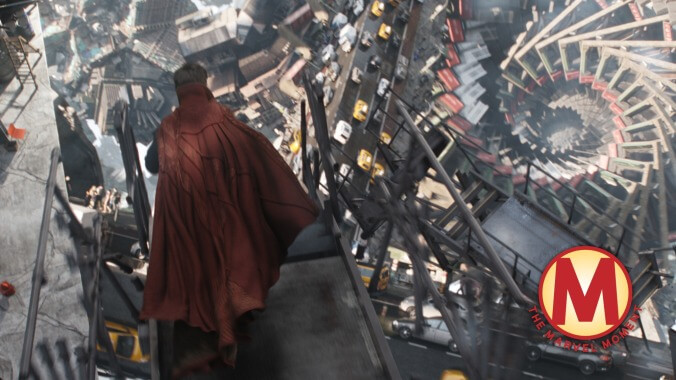With Doctor Strange, Marvel finally served up some spectacular FX eye candy
Image: Screenshot: YouTube

As has been noted in previous installments of this feature, the special effects of the Marvel Cinematic Universe were a fly in the ointment for much of the franchise’s early run. Effects work was a mandate to bring the Hulk to life, send Iron Man whizzing through space, and shrink Chris Evans into a pre-Captain America shrimp. But for a franchise ripped from the pages of comic books, Marvel Studios was slow to exploit the onscreen possibilities of adapting films from a medium rooted in visual artwork. The Avengers shook up the uninspiring set piece action with one high-flying single take, and with Doctor Strange, the MCU finally crafted dazzling onscreen spectacle as trippy and fun as the best comic book panels.
The movie smartly gets to the CGI fireworks quickly, opening on a heist in media res and twisting city streets into knots within minutes. We don’t know why Kaecilius (Mads Mikkelsen) is stealing pages out of a book, or who’s under the yellow hood of the figure trying to stop him. (It’s the Ancient One, played by Tilda Swinton.) But we’re immediately immersed in the strengths of the film as these characters emerge from a quiet temple and into a busy Manhattan street, which is disorienting enough even before the Ancient One manipulates it to writhe and twist around Kaecilius, altering gravity and physics to turn the city into a mind-bending M.C. Escher head-trip.
What follows feels like a waiting game until events lead Dr. Strange to the Kathmandu temple, where wizardry—special effects and the practice of—abound. The surgeon Dr. Strange (Benedict Cumberbatch, playing a chilly version of his other charismatic, arrogant types) loses partial use of his hands to nerve damage, eventually leading him to seek the guidance of the sprightly Ancient One. Once he’s admitted to her practice, barely 10 minutes pass without some CGI magic. A zooming ride through the multiverse; an apple disappearing and reappearing, bite by bite, as time moves around it; portals appearing in thin air used to toy with a taciturn librarian; “astral forms” that leave the body to zoom around like ghosts; an impish levitating cloak with a mind of its own—these could be panels in a comic book, coming from the mind of an artist and deftly translated to the screen.
The real star of Doctor Strange—and its CGI whizzbang high point—is the great big reality-bending set piece when Kaecilius pursues Dr. Strange through the “mirror dimension.” Once again, the city turns into clockwork pieces that bend and fold like origami. Reality ripples and warps; skyscrapers and taxi-clogged streets fold over each other, separating and combining into a 3D jigsaw puzzle of space and time. Gravity shifts as characters run over the sides of buildings and through upside-down fire escapes, while around them the city fractures and skyscrapers peel apart like string cheese. When the chase ends and heroes and villains do battle, it’s on a kaleidoscopic dance floor made of revolving city pieces.
It’s a scene unlike any that came before it, and one the MCU has not since matched in inventive effects work. (Though creativity-wise, Spider-Man: Into The Spider-Verse took the animated, multiverse premise and ran with it, going whole hog into a psychedelic palette and raising the bar on visual creativity.) Doctor Strange’s consciousness-expanding origin story was paired with a director and creative team to do it justice, showing the MCU how effects can be used to advance the story and drop viewers’ jaws at the same time.
GET A.V.CLUB RIGHT IN YOUR INBOX
Pop culture obsessives writing for the pop culture obsessed.